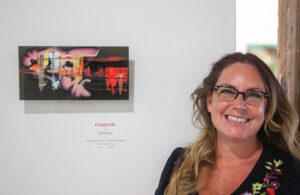Art is an endless conversation and the Brooklyn Waterfront Artists Coalition’s two summer shows seek to spur dialogue and challenge visitors to ask themselves: “What is Color” and explore the theme of a world “Out of Order.”

The Summer Group Art Show features more than 800 BWAC member’s photographs, sculptures, paintings and a variety of other medium with many exploring themes relating to a world “Out of Order.”
“There are just so many ways the world is out of order. We though it was a good theme because there are so many ways it can be addressed,” says Judith Eloise Hooper, the BWAC gallery manager.
The show’s works delve into homelessness, poverty, hunger and many pressing local and global problems.
“Art is a language that is powerful because it can reach inside and pull out of you what you need to make change,” she says.

Hazmat isolation unit
The artist Sylvia Nagy’s Agent Orange series casts a wide net to address many of societal issues. Her work is housed in a blacked out room made of garbage bags and feels like a hazmat isolation unit. Ultraviolet lights illuminate the mixed media canvases and sculptures made of metal, porcelain and dayglo paints that pop off the canvas like a Gowanus oil slick on water. The works explore environmental poisons like pollution, cell phone microwaves and the radioactive water pouring into the Pacific Ocean in Fukushima, Japan, she says.
Local fundraising aspect
For the works in the juried “Out of Order” section, 25% of sales will be donated to the Red Hook Community Farm and the Red Hook Community Justice Center, organizations working to improve the Red Hook community.
Not all works are heavy though. In John Strohbeen’s “…And There Was Light” a mirrored orb reflects time and space while a viewing hole in its center hides a Tesla coil’s spindly fingers.
One of my favorites is a series of wood panels by Bernette Rudolph that uses small twigs and wood discs to blend fluid patterns and shapes into rustic, post-modern mosaics.
Rockwell subverted
Another favorite are Beth Costello’s Norman Rockwellesque paintings that subvert Rockwell’s wholesome idealized Americana scenes with big guns (ex.: a gun-toting teacher, a father and son shooting an assault rifle and even Santa with a sidearm nestled in his belt).

What is Color?
BWAC’s second show, the National Juried Art Show, curated by the Solomon R. Guggenheim Museum’s Assistant Curator, Lauren Hinkson features 100 pieces from a national pool of artists that ask the question: “What is Color?”
A riot of color literally and figuratively floods of the canvas while wearing the 3D glasses that are part of Steve Mason’s brightly colored camouflage work “Canyon long 5d”.
Michelle Hartney seems to mock the military in “Sylvia Plath”, a work that uses military service awards in pink and red tones and gold, silver and bronze medals to create an almost pixelized flag.
And Harry Greenwald’s “Cowboy” turns pill bottles into a cowboy sculpture seemingly ready to pounce on his imaginary trusty steed if only not burdened by its weighty pill regimen.
All works on display are available for purchase and sales were strong on the show’s opening day, Judith says. “In this economy you have to be able to reach everyone and give everyone the possibility of owning art,” she says.

“The most important thing is to give artists the ability to show their work and sell,” Judith says. “A couple of times I’ve had artists come up to me and say: ‘You don’t know how important it is to me that this exists so I can show what it is I do.’ ”
BWAC’s Group Art Show and National Juried Art Show opened on July 26 and runs until August 17th. Gallery hours are Saturdays and Sundays from 2:00-6:00pm. Brooklyn Waterfront Artist Coalition 499 Van Brunt Street, 718.596.2506, www.bwac.org








